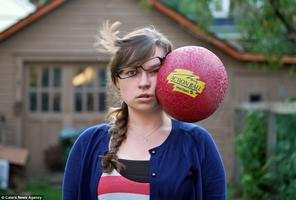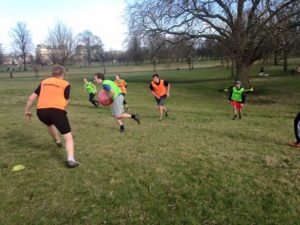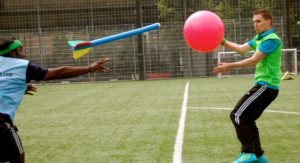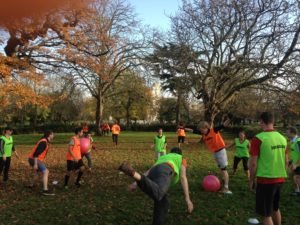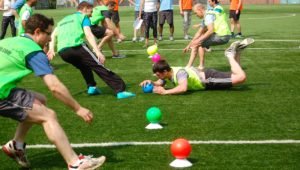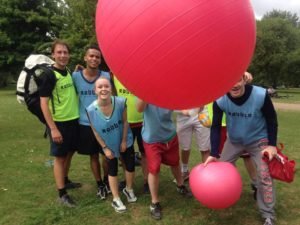Rabble Ninja Lesson 1 – How to Dodge a Ball
by Rabble Ninja Sensei – Matthew Andrews
Rabble makes people faster. It is a universally agreed fact that – unless you were already particularly fast, doing some similar sport – Rabble makes you faster. And more agile (I could pretend that I’ve always been as fast as I am but, really, it’s just that most people joined after I sped up).
But the improvements aren’t only physical. I wish I could have a before and after scan of the part of the brain that predicts other people’s behaviour.
I find one of the most satisfying things in Rabble to be: You’re running at a base and a defender is running at right angles to your path to intercept you just in front of it; you speed up; they speed up; its going to be close but you can see they’re going to make it; then, at a metre or two away, you put the brakes on and, surprised, they can’t stop in time; you enter the base.
Only slightly less satisfying (for stopping someone scoring is rarely as rewarding as scoring yourself) is if you are the defender that, seeing the above scenario about to play out, manages to stop at the right time to tag them.
It is the same mental exercise for marking someone in Vortex / Netsketball: Where the more you can predict what someone will do, the less time you have to spend watching what they’re doing; handy when you’re also trying to watch the ball on the opposite side of you.
Although sometimes you don’t want to be between the player you’re marking and the one with the ball. It can be useful to leave a gap, inviting the ball-holder to throw it to the person you’re marking. A gap small enough for you to fill it while the ball is in the air. I thought I was maybe digressing but no, this is just the next level: from predicting what someone will do, to predicting what they would do; helping someone make the decision you want them to make.
I remember watching a program about tennis. It showed how people’s reaction times are pretty much much of a muchness.It showed that tennis players weren’t waiting for the ball to be served, seeing where it was going, then trying to hit it. Instead they’d learnt to watch the other player and react to where their body is saying it will go; prediction built through years of experience.
And so I get to dodging balls (the opposite of tennis). There are two aspects to a ball being thrown at you: when and where. React too late and you get hit; too early- you can’t (ok, you can but its tricky) react in the middle of a reaction – you get hit. As for where, sometimes you might be able to dodge to the side, but at close quarters you usually have only two options: Jump or Catch.
You can try effecting what they do with things like crouching down, and maybe even telling them that you’re going to catch / dodge it. However the main thing is to watch them and they’ll tell you when and where. What to look out for? Well its not something I think too consciously about. Thinking about it now, I’ve got a couple of guesses: Perhaps the angle of their back may tell you whether to jump or catch; perhaps their arms might go back slightly just before throwing; the eyes might tell you too.
Those are just guesses though and, really, the best teacher is experience. I hope you aren’t too disappointed to find I’ve lead you all this way to tell you the best way to dodge balls, I find, is to have people throw them at you for one and a half years.
